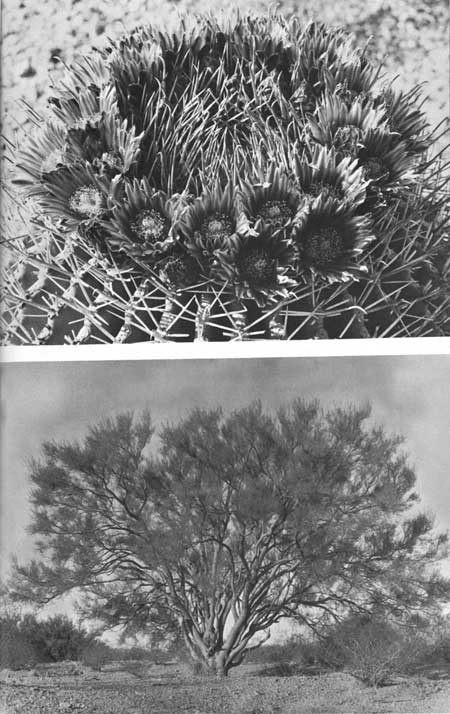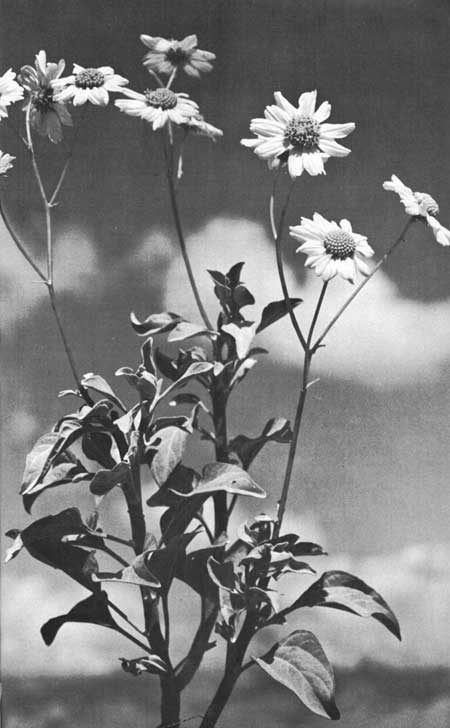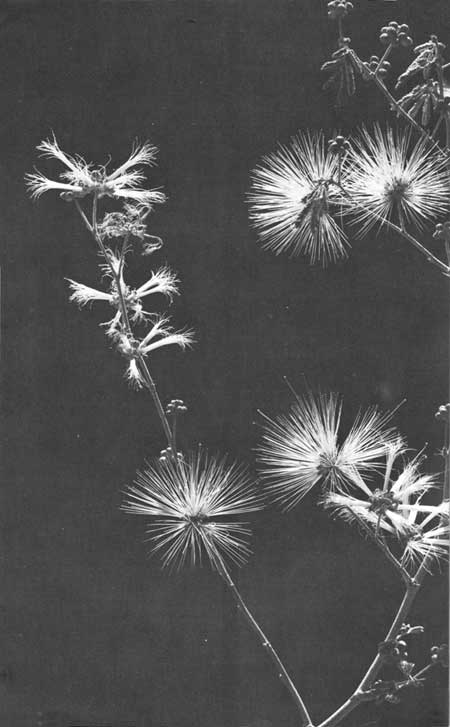|
ORGAN PIPE CACTUS National Monument |
 |
Desert Vegetation, The Principal Attraction (continued)
Nonsucculents
The nonsucculent trees and shrubs compete with the succulents and often hide them with their more luxuriant growth. They provide an open but continuous cover on the bajadas and rocky hillsides of the outlying ridges and the lower slopes of the mountains. Here ocotillos mingle with saguaros and organ-pipes. The shrubby yellow (foothill, or little leaf) paloverde is particularly noticeable because of its yellow-green bark and long, usually leafless, pendant twigs. The bark of limbs and twigs assumes the function of foliage in dry weather, with little loss of moisture. The yellow paloverde, with its lighter color, smaller leaves (which it loses early in the summer), and paler yellow flowers, differs somewhat from the larger blue paloverde. Both are members of the pea family.
 (Above) Blossoms of the barrelcactus encircle the crowns of the heavy-bodied plants. (Below) Blue paloverde trees usually grow along the borders of desert washes. |
The blue paloverde prefers the more dependable supply of moisture found along washes and drainage channels, where it often attains a height of 20 to 25 feet. Near the mouths of mountain canyons, the two species may be found growing side by side, their dense mantle of yellow blossoms from March to May helping to extend the spring flower season and marking each watercourse with a ribbon of gold.
Even before the paloverdes start to bloom, rocky ridges and boulder-strewn hillsides begin to glow with the yellow, sunflowerlike blossoms of white brittlebush. The blossoms rise on erect stems to form a thick canopy of bloom above the ashy foliage. Brittlebush is one of the most conspicuous low-growing shrubs of the desert hills and mountains. Even after its blossoming season ends in May, it flaunts an abundance of showy gray-green leaves. The brittle stems exude drops of thick sap, which harden and were chewed by the Indians. In pioneer days, this material was gathered by priests and burned as incense in mission churches; hence the local name, "incienso." The leaves are browsed by bighorn.
 Brittlebush flowers brighten rocky hillsides in early spring. |
Another attractive and interesting shrub, or small tree, of the bajadas is the jumping-bean sapium, a close relative of the Mexican jumping-bean. Its willowlike leaves seem out of place in desert surroundings. The milky sap contains an irritant that is said to have been used by Apache Indians to poison their arrow points. The rather inconspicuous flowers bloom from March to November.
Sometimes called deernut, the California jojoba is an attractive evergreen shrub usually 4 to 5 feet high with thick gray-green leaves. It is abundant on foothill slopes and along washes, especially in canyon mouths, and provides excellent browse for deer. Its fruits, which are about the size of small almonds, are edible and were eaten raw or parched by desert Indians. They contain tannin, which gives them a somewhat bitter taste. Early settlers boiled them as a coffee substitute. These "nuts" are rich in a liquid wax chemically similar to sperm whale oil.
Also of value as browse to deer and reportedly to bighorn is longleaf ephedra, or "Mexican tea." This plant is noticeable because of its lack of conventional leaves and because of the dense, bushy growth of erect, jointed, green to yellow-green stems. Early settlers made a palatable drink by steeping the dried stems and flowers. Clusters of small yellow blossoms, abundant in the spring, attract insects.
Wolfberry (graythorn, or desertthorn) grows as a shrubby tangle of stiff branches and spinelike twigs, which provide ideal cover for coveys of Gambel's quail and other birds. The plant leafs out with the winter rains, and it flowers from January until April. The pale purple blossoms mature to form small red fruits, or "tomatillos" (little tomatoes), eaten by birds and mammals and, in the past, by desert Indians. Wolfberry, of which there are several species in the monument, sheds its small fleshy leaves during periods of drought but refoliates quickly after a rain, sometimes producing a second crop of flowers.
A low-growing shrub, the falsemesquite calliandra, or fairy duster, covers rocky slopes with its feathery blossoms of pink and white in the early springtime.
 Delicate pink and white blossoms of falsemesquite calliandra, or fairyduster, decorate the slopes from February to May. |
Relatively rare in the monument, but occasionally found on rocky slopes of the southern end of the Ajo Mountains, is the grotesque bursera, or elephanttree. This shrubby tree, easily frosted, is another of the Mexican forms at home in limited localities north of the international boundary where temperatures remain high the year around. The stem is short but thick and the crooked branches taper rapidly, their shape suggesting the trunk of an elephant. The bark is thin, a papery whitish outer coat covering an inner green layer over a thicker red underbark that exudes a blood-red sap if broken. The July-blooming flowers are small and inconspicuous.

|

|
| NPS History | History & Culture | National Park Service | Contact |
|
Last Modified: Sat, Nov 4 2006 10:00:00 pm PST |


